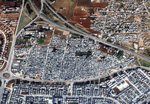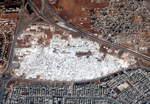15 May 2013, Geneva, Switzerland - In its latest humanitarian bulletin on Syria, OCHA warns that “the humanitarian situation in Syria is catastrophic” and calls the relief needs of populations affected “immense.” Fierce fighting across large parts of the country has led to massive displacement of civilians and mounting refugee outflows. Valerie Amos, UN Emergency Relief Coordinator, told the UN Security Council that the situation in the country is a "humanitarian catastrophe, with ordianry people paying the price of the failure to end the conflict." Over 70,000 people are believed to have been killed since the conflict began two years ago.
An estimated 6.8 million Syrians, or almost one-third of the entire population, now require humanitarian assistance, including 4.25 million internally displaced people. This marks an increase of 5.5 million affected people since March 2012. About 3.1 million, or some 50 per cent of those who require assistance, are reportedly children.
UNOSAT has been supporting OCHA, UNHCR, UNICEF, and other UN agencies with dedicated impact assessment mapping and refugee camp monitoring. Initially, when the crisis erupted in 2011, UNOSAT published a monthly situation map illustrating the evolution of violence in the country covering a period of 10 months starting in December 2011. In the early stages of the crisis this information was very useful to humanitarian agencies. Later on, when the crisis deepened, these maps were replaced by specific analytical maps focusing on the impact of the conflict on civilians and on the outflow of refugees.
As OCHA reports, most recently progress has been made in organizing multy-agency aid convoys across conflict lines despite an increasingly complex security situation. These convoys travel across conflict areas to carry essential supplies for thousands of families. According to OCHA, from January to April 2013, some 764,000 people have been reached by these convoys sent to areas often very hard to access. Once access into hot-spot areas has been established, agencies have been able to provide additional assistance through regular programme activity.
UNOSAT remains engaged in supporting humanitarian agencies with ad-hoc mapping and overall monitoring of the refugee outflow. Einar Bjorgo, UNOSAT Manager, said “in some cases the situation on the ground changes so rapidly that we had to resort to video-maps to illustrate the development of refugee camps.” As UNOSAT satellite analysis over Syria enters its third year, the feedback received from the field remains very positive. A UNICEF official based in Jordan wrote recently: “This is incredibly useful and I see people using the map constantly.”
Public satellite imagery over Syria is more and more abundant. In this example, the commercial satellite QuickBird, owned by DigitalGlobe, captured images of this area of Hama that was razed in the first week of October 2012 according to media reports. Hundreds of structures within an 80 hectare area in the north of the city are still visible in the 12 December 2011 image (left) and are absent in the 23 October 2012 image (right).
Images copyright: DigitalGlobe 2012.



